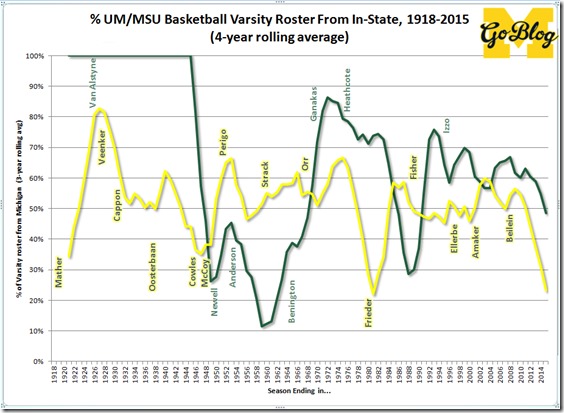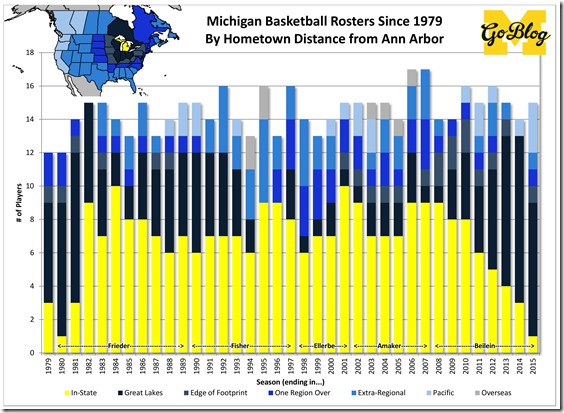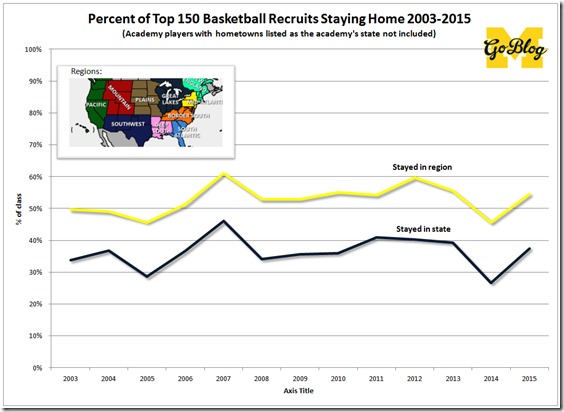I knooowww you belooooong to soooooomebody neeeeww.
But toniiiiiight you belooooong to me.
Is the state of Michigan driving kids away from in-state schools? This year Tom Izzo rode an easy bracket to a Final Four appearance with a down-year team, then put together a very good recruiting class, even if his top target went to Purdue. Since he really has no need to make excuses at the moment, his friends are doing it for him. Before the tournament it was "Tom Izzo doesn't cheat but everyone else does." Which is generally true—on a scale of "Look at our shiny Tommy Amaker" to "Ridin' this Calipari" MSU is definitely near the Amaker extremity of programs that regulate that stuff as best they can (nobody, including Michigan, would stand up to scrutiny, nor should).
The latest non-excuse excuse is MHSAA's arcane rule drives top 150 talent out of the state of Michigan, and thus away from the in-state schools. An article by Graham Couch—
Hey where are you going? Stop. At least see where I'm going with this. Yes the Couch article was exactly the paragon of crappy slappy journalism you'd expect from one of the worst journalists of my generation. He interviewed a couple of Detroit high school basketball coaches about the "parasitic" effect of AAU and national prep powers—as if anyone but the in-state schools would be helped if Miles Bridges was forced to live in Flint rather than a prep school down the street from Marshall University.
But that doesn't preclude a possibly real effect of talent leaving the state (and not looking back) due to overly stringent rules put in place by the body that controls high school athletics.
Couch cares because Michigan State in basketball is like an SEC football school (minus the cheating), in that their historical success is tied to proximity to talent. If the state of Michigan is systemically exporting more talent than it's bringing in, that's bad for the in-state schools. However if one program is suffering from greater national vagrancy because it's built on recruiting in-state talent and doesn't know how to compete for regional and extra-regional players, that's just that program falling behind the times.
Are more basketball players playing elsewhere in general? Is this state different somehow? I realized I didn't have a study to link to show this, so I made one.
And found M and MSU are getting less in-statey:
Bentley has a list of all Michigan basketball players except for 2008 (I added). For Michigan State I could only find a list of letterwinners, so I compared just Michigan's varsity:
A lot of wiggle: This isn't like football where there's over 100 players on each roster; if three freshmen from a prep school decide to attend the same college you'll get a big jump on the graph above.
There are two major national events responsible for two huge dips: World War II (1942-1945), and the implementation of Title IX, which regulations were promulgated in 1974 and clarified in 1979. The "three-part test" comes from '79, and it's from then through '82 that the three-part standards, e.g. having as many girls on official athletic rosters as boys, truly went into effect.
That said, there's a historical mean of around 50% in-state for Michigan and about 60% for Michigan State—not enough difference on a squad of 16 players to make a difference. Both schools have recently gone more out-of-state, Michigan to a much greater degree.
What about the Wolverines?
[Hit the jump]
The out-of-state proportion is at historic high, but only because Beiein's been doing a lot of next-state-over recruiting—Indiana, Ohio, Ontario, etc.:
For this and the next chart I used Bentley's full rosters, which up until 1979 included junior varsity, scout team, and "amateur" level guys, as well as those redshirting.
WWII brought a lot of trainees from the region to Michigan-housed programs. That big uptick in the late 1970s was Orr packing the roster with JVs; the sudden dip in 1980 was Title IX putting an end to that.
The roster Since Title IX:
So in the extremely small sample size of basketball rosters Michigan under Beilein has basically expanded Michigan's recruiting footprint to places still close enough to Ann Arbor for Mom and Dad to drive to, but doesn't differentiate between in-state and out-of.
And Nationally? This was hard and I couldn't complete a satisfactory study because so many kids are listed by the recruiting sites by their academies instead of their hometowns, which I take to be the operative factor (and I'd like to test that). Right now I'm crowdsourcing the list of guys I couldn't identify in a once-over:
Doing a project to see how academies affect hoops recruiting. Wanna help fill this out: https://t.co/yUpevHOOs6 ? PM me your gmail account
— Seth M. Fisher (@Misopogon) May 20, 2015
For now I left those guys out of data taken mostly from Rivals because they got back to 2003. Initial results say:
Things really haven't changed in the last decade-plus. A little over a third of players then and now stayed in-state, and just over half stayed in their home regions. That's a high level of vagabonditry, but it's been going on a long long time. The difference is a huge jump in the number of kids who attend national academies starting in 2007—that's for a later discussion.
Is (the state of) Michigan significantly different then? With so few top 150 recruits from the state it's hard to tell. M guys bolded:
| Year | Remained in-state | Stayed in Great Lakes | Left Region |
|---|---|---|---|
| 2003 | Brandon Cotton, Drew Naymick, Dion Harris | Walter Waters, Brandon Bell | Kirk Walters, Brandon Jenkins |
| 2004 | Marquise Gray, Drew Neitzel, Ronald Coleman, Darryl Garrett, Goran Suton | (none) | Malik Hariston, Joe Crawford, Al Horford |
| 2005 | (none) | Wilson Chandler, Jabari Currie | Chris Douglas-Roberts, Eric Devendorf |
| 2006 | Tom Herzog, Deshawn Sims | Tory Jackson | Ramar Smith |
| 2007 | Kelvin Grady, Manny Harris, Durrell Summers, Kalin Lucas | Darquavis Tucker | Tracy Smith, Laval Lucas-Perry |
| 2008 | Draymond Green | (none) | Jason Washburn |
| 2009 | Derrick Nix | (none) | Donnovan Kirk, DaShonte Riley |
| 2010 | Keith Appling, Trey Ziegler, Ray McCallum | (none) | (none) |
| 2011 | Brandan Kearney, Dwaun Anderson, Carlton Brundidge | Amir Williams, Jalen Reynolds | Tommie McCune |
| 2012 | Matt Costello, Denzel Valentine | Jodan Price | Sherron Dorsey-Walker, Javontae Hawkins, Jordan Hare |
| 2013 | Derrick Walton | (none) | Monte Morris, Wesley Clark, E.C. Mathews, James Young |
| 2014 | (none) | Darrell Davis | Justin Tillman, Jaylen Johnson |
| 2015 | Deyonta Davis | (none) | A.J. Turner, Trevor Manuel, Eric Davis |
I would guess the results of the academies research will show a lot more, but small sample size makes this an argument over anecdotes. Anecdotally, the state is probably losing top 150 types to national academies, who shop the kids nationally, but no more than other states. This is a problem if getting local kids who haven't explored all of their options is a major part of your recruiting strategy. It's not a problem for anyone else.
I do think the states with major national academies are at an advantage, just like Michigan hockey should benefit from having the USNDTP in town. The Virginia schools, Boston schools (they drive up to New Hampshire), and Wichita State have probably gotten a few more kids here and there from familiarity or the better scouting opportunity. It's not a lock; Huntington School is down the street from Marshall and what have they done?
*Which brings us back to what's up with the mitten?
The state's general population loss is a red herring: sports teams recruit disproportionately from social classes who aren't as mobile. However many families with both the means and a potential NBA player will move to wherever can maximize their kid's potential. While the NCAA talks itself in circles about how their amateur athletes are supposed to be doing this as an extra-curricular fun thing, actually competing for an NCAA scholarship and a career is an all-in prospect. Parents will dump life savings into coaching, travel, gear, whatever it takes because the other kid's parents are doing something to get an edge too. Getting seen against top competition is a huge part of that, so the talent will collect wherever that's happening.
AAU made a business out of that—if it's shady so are rock tours and the people who organize them for the sake of being in the room when Atlantic and Sony are trying to sign them.
Couch did have a point about MHSAA's controversial [no traveling beyond] 300-mile rule. The rule was instituted to put a stop to arms races—Come to DCD, get a free trip to Hawaii!—and has generated all sorts of headaches for Michigan teams, particularly those in the western part of the state who want to be part of Chicagoland competitions. The systemic advantages for wealthy private schools overwhelm the rule's intended effect. So the rule has two main effects:
1) lots of silly citations, for example Fenton (near Holly when you're driving up I-75) got in trouble for going to Notre Dame's football camp because an Arizona team flew there too, and
2) AAU and elite prep programs choose to set down elsewhere.
The 300 rule is still around because in high school sports the little programs are a humongous majority, and coaches tend to feel entitled to their backyards' talent.
Michigan, MSU, and the directional schools would probably appreciate a major academy in-state—we've gotten some nice things from DCD in the past—and there is enough talent around to support one. That won't happen unless they put huge pressure on MHSAA to allow it first.
Conclusions? Vague. At best you can say basketball recruits since the early 2000s have been more regional and more national in choosing schools, or the coaches of those schools cast wider nets. The last few years hasn't changed much except Michigan jumped onto the trend and Michigan State is slowly getting caught by it, maybe. One-and-done has pushed maybe 1 in 10 players from the top 150 into schools that will let them comfortably wait to be drafted.



